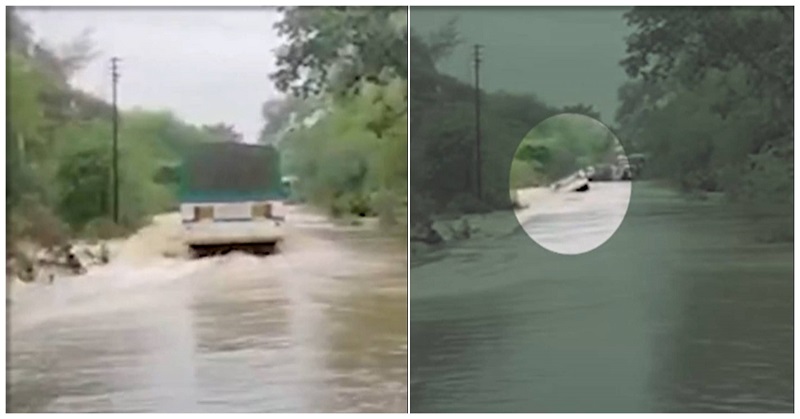
महाराष्ट्र: बरसात के मौसम के कारण यवतमाल जिले में एक घातक त्रासदी हुई, जिसमें उमरखेड़ में दहागाम के पास एक एसटी बस नदी की बाढ़ में बह गई, जबकि चालक और कंडक्टर सहित तीन लोग अभी भी लापता हैं।
सुबह पुल पर पानी होने के बावजूद लापरवाह चालक ने बस को आगे बढ़ा दिया. हालाँकि, जैसे ही वह आधे रास्ते पर पहुँचती है, बस पानी के बहाव से तनावग्रस्त हो जाती है और अचानक पुल से नदी में गिर जाती है। यह दृश्य देख नदी के दोनों किनारों पर खड़े स्थानीय लोग चिल्लाने लगे.
ગામલોકોની નજર સામે જ નદીમાં સમાઈ ગઈ આખેઆખી ST બસ, આ વિડીયો જોઇને તમે હચમચી ઉઠશો #Maharashtra #bus #river #trishulnews #topnewstoday #gujaratinews #breakingnews #newsupdate #viralvideo pic.twitter.com/WqLX4ljRX7
— Trishul News (@TrishulNews) September 29, 2021
इसके साथ ही स्थानीय लोग नदी में कूदकर लोगों को बचाने में जुट गए. स्थानीय लोगों ने अपनी जान जोखिम में डालकर बस में सवार 4 अन्य लोगों को बचाया। एक अन्य घटना में उत्तर प्रदेश के बांदा में अलग-अलग हादसों में 6 बच्चों की दर्दनाक मौत हो गई.
सभी बच्चे अपने परिवार के साथ बुन्देलखण्ड के पर्व महालक्ष्मी पूजन में शामिल होने के लिए तालाब पर गये थे। मृतक बच्चों में 2 भाई-बहन भी शामिल हैं. यह त्रासदी बांदा के 3 तालुकाओं में हुई है। बांदा सदर में एक, नरैनी तालुका में 3 और बबेरू में 2 बच्चों की मौत हो गई.
भारी बारिश के कारण अक्सर कुछ ऐसी घटनाएं सामने आती हैं, जिसमें कुछ मासूम लोगों की जान चली जाती है, लेकिन अब भी दो अलग-अलग घटनाओं में 7 लोगों की मौत हो गई है, जिससे परिवार सदमे में है.
Ensuring safety while traveling by State Transport (ST) buses involves both the responsibility of the bus operators and the passengers. Here are some key safety tips and measures for a safe journey on an ST bus:
1. Bus Condition and Maintenance
- Regular Maintenance: The bus should undergo regular maintenance checks to ensure that all parts, including brakes, tires, lights, and the engine, are in good working condition.
- Emergency Exits: Make sure the emergency exits and hammers (to break windows in an emergency) are clearly marked and functional.
2. Driver Safety
- Qualified Drivers: Ensure that the bus driver is properly licensed and has undergone safety training, including defensive driving techniques.
- Adherence to Speed Limits: Drivers should adhere to the prescribed speed limits, especially in areas with poor road conditions or heavy traffic.
- No Overtaking in Dangerous Zones: Drivers should avoid overtaking in areas with limited visibility, like curves or hills.
3. Passenger Behavior
- Stay Seated: Passengers should remain seated while the bus is in motion to prevent falls and injuries. If standing is necessary, hold onto the handrails securely.
- Avoid Distracting the Driver: Passengers should avoid engaging in behavior that could distract the driver, such as loud talking, arguing, or standing near the driver’s seat.
- Follow the Driver’s Instructions: Listen to any instructions or announcements made by the driver, especially in case of emergencies.
4. Boarding and Alighting
- Use Designated Stops: Always board and alight the bus at designated bus stops or terminals. Avoid running to catch a moving bus.
- Wait for the Bus to Stop Completely: Ensure the bus has come to a complete stop before attempting to board or get off.
- Exit Safely: When getting off the bus, look both ways for oncoming traffic before crossing the road.
5. Luggage and Personal Belongings
- Secure Luggage: Place luggage in designated storage areas or securely under your seat to avoid obstruction in aisles.
- Keep Valuables Safe: Keep your personal belongings, especially valuables like wallets, phones, and bags, close to you at all times to prevent theft.
6. Emergency Preparedness
- Know Emergency Procedures: Familiarize yourself with the location of emergency exits and the procedure for using them.
- Report Suspicious Activity: If you notice any suspicious behavior or unattended luggage, inform the driver or conductor immediately.
- Stay Calm in Emergencies: In case of an emergency, remain calm and follow the driver’s instructions. Use emergency exits only when directed.
7. Road Safety
- Adhere to Road Rules: The bus should follow all traffic laws, including stopping at red lights, giving way to pedestrians, and avoiding reckless driving.
- Avoid Night Travel if Possible: If the road conditions or visibility are poor, it might be safer to avoid night travel.
8. Weather Precautions
- Be Cautious in Bad Weather: In case of adverse weather conditions like heavy rain, fog, or snow, the bus driver should reduce speed and maintain a safe distance from other vehicles.
- Prepare for Delays: Weather can cause delays, so passengers should be patient and understanding if the journey takes longer than expected.
9. Health and Hygiene
- Stay Hydrated: Bring water along, especially for long trips, and stay hydrated.
- Use Masks and Sanitizers: In the post-pandemic era, wearing masks and using hand sanitizers can help prevent the spread of germs.
- Cleanliness: Avoid littering inside the bus and dispose of any trash in designated bins.
10. Security Measures
- CCTV and Surveillance: Some ST buses are equipped with CCTV cameras for passenger safety. Be aware that your actions may be monitored for security purposes.
- Police Assistance: In case of serious incidents, passengers or the driver should contact local authorities or the police for assistance.
11. Awareness and Education
- Passenger Awareness Programs: State Transport authorities should conduct regular awareness programs for both drivers and passengers on safety practices.
- Driver Training: Regular training programs for drivers on first aid, road safety, and emergency handling can enhance overall safety.
By following these safety tips and ensuring that both drivers and passengers adhere to them, the safety of ST bus travel can be significantly improved, leading to a more secure and comfortable journey for everyone.